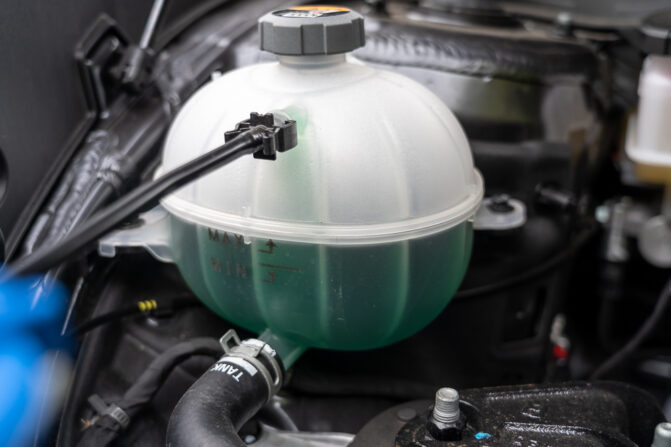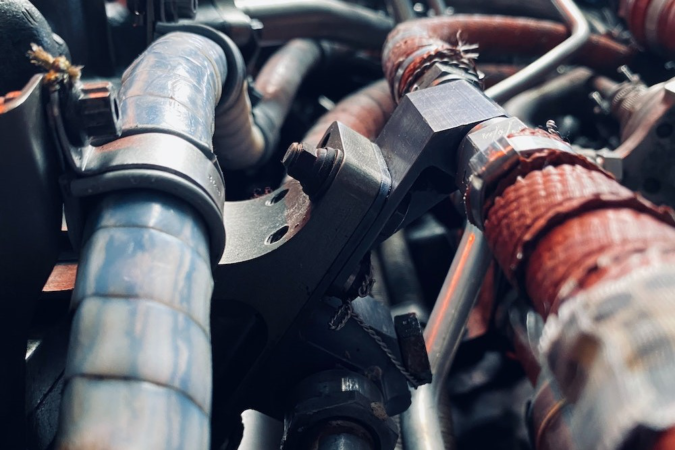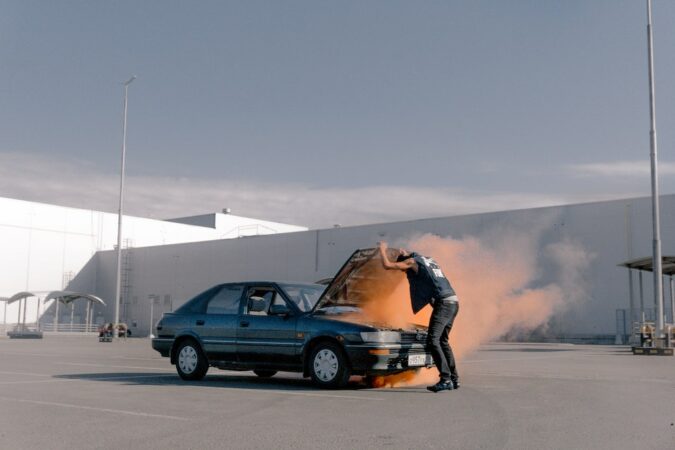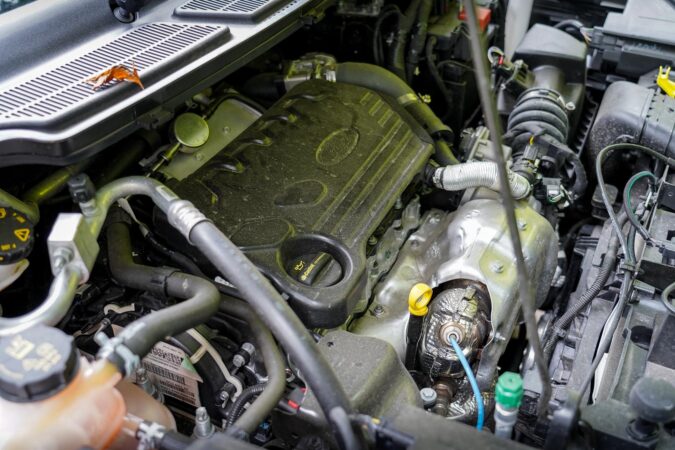With countless mini-explosions occurring throughout its lifespan, it’s no small wonder that engines do run pretty toasty all of the time. How hot, you might ask? Well, the typical operating temperature of a car engine is between 195°F to 220°F. We can say that 250°F is borderline overheating, meanwhile, motor oil could heat up to over 300°F. But can you put water in coolant tank to cool it all down?
Fun fact; the combustion chamber in the engine, where those mini-explosions and ignition occur, can get up to a whopping 4,500°F on occasions. Sometimes, and in higher performance engines, perhaps even closer to 6,000°F. The exhaust gases alone could rise to 2,800°F or higher. However, at such high temperatures, this amount of heat is unsustainable, as it could easily start melting the engine.
Metal components melt at 2,500°F, while alloys start melting at around 1,200°F. Thankfully, having to face the prospect of a melted engine is never something that you’ll have to worry about, thanks to coolant. Or, ‘antifreeze’, as some might call it. Coolant is mostly responsible for keeping your engine under more tolerable temperatures. But in a pinch, can you put water in coolant tank to mix it up?
- What Is Coolant?
- Why Mix With Water?
- Using Just Water?
- Consequences
- Type Of Water
- Emergency Use
- FAQs
- Final Thoughts
What Is Coolant, And How Does It Work?
Before we look closer at can you put water in coolant tank, it’s wise to learn more about how coolant can function, in the first place. So, we made mentions of “tolerable” temperatures earlier; what does this mean? Altogether, your engine’s cooling system can reduce the heat of the engine to between 265°F and 475°F. As you can see, it’s a huge drop from the four-digit readings earlier on.
In particular, that aforementioned temperature reading happens by the cylinder walls. This is where the heat exchange takes place, where the coolant absorbs and takes in heat from the engine, before then cooling it down. It’s said that most of an engine’s energy released during combustion, around 70% of it, is turned into heat. That’ll be the challenge that coolant has to overcome to keep it cooled down.
In the old days, some cars (like the Volkswagen Beetle) were air-cooled. It relied on fresh, outside air rushing past the engine to keep it cooled. On the other hand, practically every car these days adopt a liquid-cooling solution, where coolant (aka antifreeze) flows around to cool the engine and its many moving parts. Engine coolant is usually made from either ethylene glycol or propylene mixture.
As you look at your car, you’ll normally see it as green, blue, pink, yellow, orange, or red in color. Besides being a cooling solution to temper down the engine’s heat, coolant also has other, secondary functions. For example, it carries anti-corrosion additives that prevent a build-up of rust within the cooling system. Elsewhere, it might be formulated to last longer and work better under high temps.
How Does Your Car’s Cooling System Work?
In that case, how could liquid coolant start to cool the engine down? For starters, it circulates around the engine through a complex series of plumbing, tubing, hoses, and other passageways. Look inside the engine, and you’ll find these passageways surrounding the cylinders and other cast or machined into the block. Here’s a quick start-to-finish flow of where the coolant goes around your engine:
- As you start your engine, the water pump begins putting centrifugal force to start circulating coolant around the engine. The pump takes in coolant from the radiator, which is fed by the coolant tank.
- The water pump will now flow coolant to the (hot) engine. It goes through the passageways on the engine block, before finally reaching the cylinder walls.
- Specifically, the plumbing will be cast to the hottest parts of the engine. For example, the cylinder walls, where combustion occurs inside of it. In addition, the exhaust valves, as exhaust fumes can get pretty hot.
- Once chilly coolant flows inside the engine, it begins a heat-exchange process to absorb the engine’s heat. In doing so, the cold coolant now starts turning toasty, while keeping the engine’s temperature in check.
- At this point, the water pump’s pressure will continually flow the hot coolant back to the radiator. A radiator is also technically a heat exchanger.
- Here, hot coolant flows within the radiator through narrow tubing that runs through a vast array of fins.
- As you drive on by, the radiator will create aerodynamic drag to attract cooling air from outside. It might, as you’re idling, for example, be forced in by the radiator fans.
- By using the atmosphere to extract heat away from the coolant, it starts to cool down. Finally, the chilly coolant goes through the pump, and the cycle repeats.
What Goes On In Your Car’s Cooling System?
Besides those abovementioned components, your car’s cooling system also comprises a few other key players. For the most part, their job is to ensure a smooth and reliable cooling operation that can assuredly bring the engine temperature down to comfier levels. Besides that though, they otherwise function as a failsafe, to keep everything in check. Here are the most important ones:
- Radiator Pressure Cap – On your radiator cap, you’ll find a pressure release valve, given the fact that coolant can build up immense pressure. Often, it’s limited to around 15psi. As your coolant begins to heat up excessively, the pressure valve opens and leads the coolant into an overflow tank. This prevents air from building up inside the cooling system. Air bubbles, as we’ll later, are detrimental to cooling.
- Thermostat – Your thermostat is essentially the brain behind how much coolant flows through your radiator and water pump. At lower temperatures, the thermostat shuts down coolant flow, which can get the engine to heat up to its optimal operating temperatures. Once the engine gets hotter, around 180°F, the thermostat opens, gradually getting more and more coolant circulating through it.
- Heating System – Funnily enough, your heater could also be considered a part of the cooling system. A key part of it is the heater core, which is sort of a smaller radiator, sitting behind your dashboard. As you turn on the heater, a fan blows air through the heater core. Of course, this cold air naturally draws in heat from the hot coolant flowing from the engine to the core, keeping you warm.
Can You Mix Coolant In The Tank With Water?
Ah, but despite the many benefits of coolant, it’s actually worse to run purely coolant compared to a “coolant mixture”. The latter of which contains water. That’s because raw, straight coolant doesn’t attract heat as well as water can. That then leads us to the question of can you put water in coolant tank? Yes, but only when mixed appropriately with a set ratio of coolant, usually a 50:50 mix.
In other words, that’s 50% coolant in the coolant tank, mixed in with 50% (equal parts) water. This is the case with most vehicles and off-the-shelf coolant solutions. Note, some coolants that you could buy sometimes already come pre-mixed with a bit of water. Hence, requiring no manual mixing from you. Furthermore, certain vehicles in varying applications may employ a different ratio than 50:50.
At the very most, it shouldn’t be any higher or lower than 70:30 to 40:60 (that’s water-to-coolant). In the right mixture, water and coolant together perform far better than just running straight coolant, or only using water (more on that later). When mixed properly, this “coolant mixture” of both water and coolant massively lowers the freezing points, and correspondingly increases the boiling points.
It’s a win-win. For some context, let’s use a typical ethylene glycol-based coolant (C2H6O2), which is the most popular mixture for antifreeze:
- Only Water – Freezing point of 32°F (0°C), with a boiling point of 212°F (100°C)
- Only Antifreeze – Freezing point of around 8.6°F (-13°C), with a boiling point of 375°F (190°C)
- 50:50 Water-To-Antifreeze – Freezing point of -35°F (-37°C), with a boiling point of 223°F (106°C)
- 40:60 Water-To-Antifreeze – Freezing point of -49°F (-45°C), with a boiling point of 260°F (127°C)
- 30:70 Water-To-Antifreeze – Freezing point of -67°F (-55°C), with a boiling point of 235°F (113°C)
Can You Put (Straight, Pure) Water In Coolant Tank?
With that in mind, can you put water in coolant tank? Well, and as we noted earlier, coolant (aka an antifreeze solution) works best when mixed in with some water. That’s because water is great when it comes to attracting heat, which could then be chemically exchanged and absorbed into the coolant. A downside of water, however, is that it doesn’t perform well at too high or too low of a temperature.
Here’s what happens when you run pure, straight, 100% water as a replacement for coolant:
- At higher temperatures, water (while good at attracting heat) would start boiling pretty quickly. If it isn’t balanced out with coolant, that water will eventually evaporate, and develop air bubbles inside the cooling system. Thus, compromising the coolant’s ability to cool down the engine.
- At lower temperatures, water freezes outright and turns into either ice or a crystalline, icy solution. This happens, for instance, when you walk up to your car early on a cold, winter’s morning, as your water-based coolant is left to freeze. As you can imagine, your cooling system can’t circulate ice.
- Corrosion can start building up inside the cooling system. Parts of the pump, radiator, passageways, and so on are made from either aluminum, metal, or some other ferrous compound. Unlike coolant and its anti-corrosive additives, water alone could contribute to causing that rust to appear.
On the other hand, running pure coolant (without any water) isn’t good either. It doesn’t feature an ideally low enough freezing point for the colder parts of the world. Yet, and while it does have a high boiling point, the coolant’s ability to attract and dissipate heat diminishes beyond 0°C. By mixing coolant with water, it’ll more reliably stay in a liquid form, neither as vapor (too hot) nor as ice (too cold).
What Are The Consequences Of Putting Only Water In Coolant Tank?
Now, some would disagree with our point of can you put water in coolant tank. They’d make the argument that they don’t live and travel in (or through) cold climates. Perhaps, they live in warmer or hotter parts of the world, like Asia, the Middle East, Africa, and so forth. Therefore, they’ll say that it’s not necessary to have the all-season or all-weather properties of coolant/antifreeze.
Or, they may argue that they don’t drive their cars often, or just take it on shorter commutes or trips. Hence, they’re not bothered by the fairly low boiling point of straight (no-coolant) water. Despite all this, we stand by our point (as most mechanics agree with), in that running your engine’s cooling on water alone (or using undiluted coolant) is a terrible idea. In the real world, this could be dangerous.
Here are some of the reasons why running straight water in your cooling solution can be detrimental to your car:
- Even in modestly chilly climates, water could begin to freeze up pretty rapidly.
- As your engine begins to heat up or overheat, water starts boiling away and evaporating.
- With evaporation, air bubbles are introduced, lowering its overall boiling point further.
- There’s a greater risk of your engine overheating and seizing up.
- Without anti-corrosive additives, it’ll rapidly accelerate rust in the engine and cooling system.
On another note, it’s worth mentioning that when you add water to mix in with coolant, you have to carefully pick what water you’re using. Avoid using regular tap water. The latter often contains some leftover impurities or other contaminants, which could affect its cooling abilities. However, the use of pure distilled water isn’t good either, as its imbalanced ions could strip and damage metals.
What Sort Of Water Can You Put In Coolant Tank?
So, about that tap water versus distilled water situation. Why is it that you shouldn’t use either one? In actuality, and while the side effects aren’t immediately catastrophic, using either tap or distilled water to mix with coolant isn’t optimal. Here’s a quick rundown to explain why when you’re mixing water with coolant, regular tap or distilled water could be bad:
- Tap Water – It’s filled with minerals, most predominantly magnesium and calcium, which could leave behind deposits. A build-up of these mineral deposits can significantly hinder the effectiveness of the water regarding cooling. Using the hard water scale, just 1/16-inches is enough to reduce by up to 40% the capabilities of your engine’s cooling solution. Thus, possibly causing overheating.
- Distilled Water – Yes, it’s been stripped and is devoid of any minerals that give way to a build-up. Yet, the distillation process could have adverse effects on the engine. Without minerals like magnesium or calcium, distilled water doesn’t have extra electrons, leaving it ionically imbalanced. Rather, it’ll then start stripping electrons from the metal in your cooling solution, which is just as damaging.
The best type of water to use when mixing with coolant is softened water, as a great middle ground. In practice, softened water doesn’t carry any magnesium or calcium deposits. Rather, this softening process replaces them with sodium. Therefore, it still carries ions that distilled water lacks. And as a result, softened water doesn’t need to strip your engine’s metal of electrons for it to even out.
Can You Put Water In Coolant Tank In An Emergency?
But what if you’re in an emergency situation, such as getting stranded in the middle of nowhere? A leak has appeared in your cooling system, and the coolant is all but gone. Not a single workshop or garage is in sight for miles, and the only thing you have is a well or tap with water. In this case, can you put water in coolant tank; just water and nothing else to top it up? Technically, yes.
While not ideal, running an engine’s entire cooling system with just water (no coolant, still) is better than nothing at all. Your engine isn’t likely designed with an air-cooled configuration. Therefore, the radiator filled with nothing but air will almost immediately begin to overheat. Not only that, it might overheat so badly, to a point where it may begin scarring and damaging the engine, or seizing it.
“Seizing” is described as your engine locking up or freezing altogether. In the case of there being too much heat, your engine’s pistons could literally melt and fuse with the cylinder walls. When it occurs, your engine is practically scrapped, requiring an extensive rebuild, recondition, or replacement as a whole. With that in mind, and if you really need to, putting straight water is still acceptable.
Although, you shouldn’t do this for too long. At least, until the engine starts to heat up excessively. A neat trick will be to fill up the coolant tank with water (in an emergency). Then, keep a close eye on the temperature gauge, and stop your car by the side of the road to cool it down, if needed. Once you reach the nearest workshop, promptly repair what leaks there are, and add some coolant in.
Frequently Asked Questions On Can You Put Water In Coolant Tank
Here are some of the more pressing and randomized FAQs that might be floating around your head when pondering over can you put water in coolant tank…
1. How Can You Get Your Hands On Softened Water?
Unlike tap water, which is readily accessible. Or, even distilled water, which you can purchase in bulk online; softened water isn’t as easily acquired. There are some shops that sell distilled water which is masquerading as softened water, but this is an exaggeration at best. You shouldn’t purchase this, as it’s still distilled water, which isn’t the most ideal solution to mix with coolant, as we’ve learned.
There are two ways that you can get your hands on softened water:
- The easiest method is buying a water softener. These systems are essentially water filtration systems that you can install in your house, which softens water leading from the mains. While some are quite large, there are smaller water softeners that bolt onto your taps or showerhead.
- Otherwise, you could make softened water without a softener system. You’ll begin by boiling water, before leaving it too cool. The latter is required if your water is permanently hard, which will always have some calcium or magnesium in it. To combat this, add some washing soda to the water, using the right mixture and ratios as described on the box.
2. Do You Need To Put Water In Every Coolant/Antifreeze Mix?
The best way to know is to read the label on the bottle of coolant (aka antifreeze). Note that certain coolant and antifreeze products already come pre-mixed with the appropriate ratio of water. If that applies to you, then you could simply pour it into the coolant tank, without mixing any more water. If you’ve purchased a pure coolant or antifreeze solution, then that’ll have to be mixed with water.
3. How Can You Know What Type Of Coolant To Use?
Besides worrying about can you put water in coolant tank, you also have to be wary about what type of coolant you’re going to use. Different automakers prescribe varying types of coolant or antifreeze solutions, with differing performance or chemical compounds. It’s crucial that you use the right type that’s been made specifically for your car, as it can have a substantial effect on the cooling.
The best way to know what sort of coolant or antifreeze you should be using is to check the owner’s manual. To make things easier, you may also refer to the color of your coolant or antifreeze. Here are some of the most common types of coolants on the market today:
- IAT (Inorganic Additive Technology) – Not the most performant solution, as it’s usually used in older vehicles. IAT coolants require more frequent flushing and replacing, with a fluid change interval as low as 24,000 miles. Or, every 2 years or so.
- OAT (Organic Acid Technology) – Popular and commonly used in most newer vehicles, since the early 2000s. It uses neutralized organic acids (hence, the name), which makes the fluid anti-corrosive. But also, it performs better under extreme heat and pressure. As such, OAT coolants don’t require overly frequent upkeep, as they can last nearly 150,000 miles (around 5 years) before a change is needed.
- HOAT (Hybrid Organic Acid Technology) – It’s a slightly different take on OAT, which lasts just as long before a flush and change are necessary. HOAT carries a blend of both IAT and OAT.
Final Thoughts On Can You Put Water In Coolant Tank
In all, that just about rounds up our guide on can you put water in coolant tank. In short, can you put water in coolant tank? Yes, but only when it’s mixed with coolant in an appropriate ratio or roughly a 50:50 split in most cases. However, just using water, while a decent idea to get your car running in an emergency, isn’t a good idea for long-term use. It’s not ideal and could cause further damage.
Overheating and build-up of corrosion is a common adverse effect of using straight water for cooling the engine, with no coolant whatsoever. Sure, water alone is a cheaper way to cool the engine down compared to buying a bottle of coolant. On the other hand, it’ll accelerate wear on the engine, which could cause hundreds (if not easily thousands) of dollars worth of repairs that need doing.




